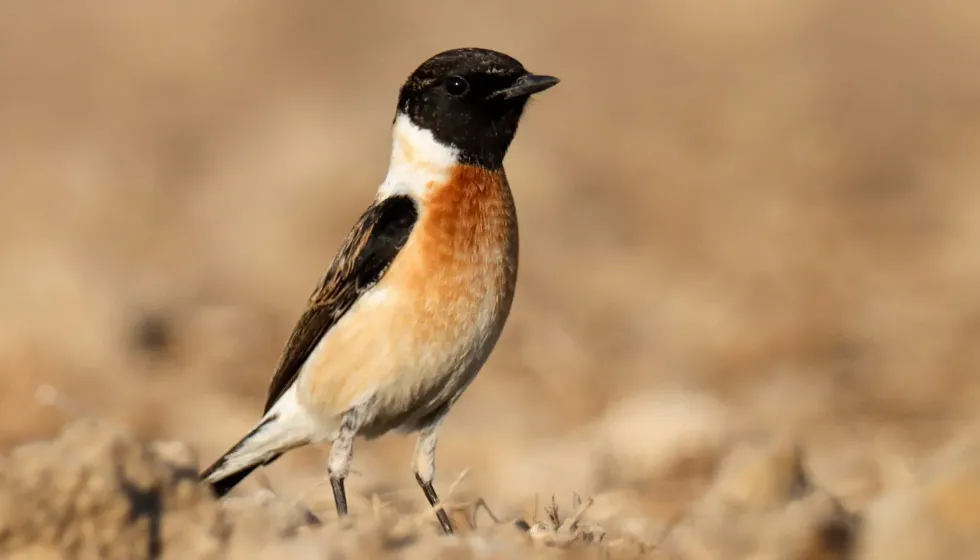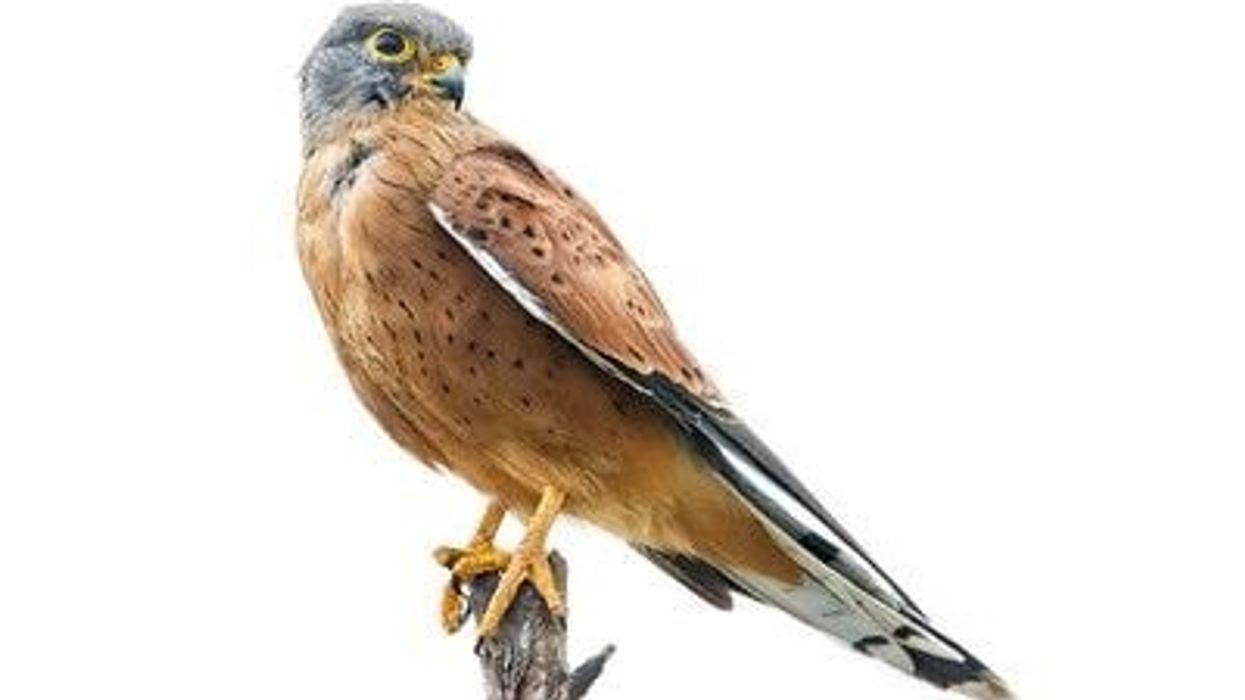Stonechats are a type of chat bird and are from the genus Saxicola, which contains 15 species of small passerine birds of the Old World. Among, these the common stonechat with the scientific name Saxicola torquatus is considered a subspecies as it contains eight species in the group including the African stonechats, European stonechats, and Siberian stonechats.
The Siberian stonechat (Saxicola maurus) is also known as the eastern stonechat.
The habitats of these birds include open scrubland and grassland with scattered small shrubs. The birds in the family are also found in swamp edges and cultivated land.
The stonechat bird is known to feed only on insects on the ground and sometimes by gleaning from vegetation. This is a feature not seen in many birds.
Although stonechats are much similar to each other, there are some notable color differences in this bird species. A Siberian stonechat male bird has a black head and an orange throat, while a female bird has brown upper parts and a brown head with neck patches.
The European stonechat breeding plumage of the male has its rump and upper tail in white and dark streaks on it.
Wings also have a narrow white patch. A stonechat bird has a black tail.
This bird species were often mistaken as a part of the family Turdidae when they are actually a part of the family Muscicapidae. Stonechats are Old World flycatchers and are found abundant in habitats all over the world.
An interesting fact on the family is that the stonechat name is given due to the stonechat call which sounds like two stones striking each other.
For more relatable content, check out these chicken facts and saker falcon fun facts.
Stonechat Interesting Facts
What type of animal is a stonechat?
Stonechats are types of small insectivorous passerine birds.
What class of animal does a stonechat belong to?
Stonechat birds fall under the class of Aves in the kingdom of Animalia. There are 15 different species of stonechats or chats found in habitats all over the world.
How many stonechats are there in the world?
The population status is not known. However, it is said that there are around 55,000,000-94,999,999 individuals of common stonechats spread over their habitat.
Where does a stonechat live?
Common stonechats or African stonechats are found in sub-Saharan Africa, as far north as Senegal and Ethiopia. A population of this species is also found in southwest Arabia, Madagascar, and Grande Comore. This huge distribution has led to the formation of different species of the genus.
The European stonechat is found in Europe and widely in north Africa.
The breeding range of the Siberian stonechat starts from temperate Asia. The range is from Siberia south to the Himalayas, southwest to China, towards the west to Turkey, and the regions near the Caspian Sea. The bird is found wintering in Japan, Thailand, and India, and towards the west to northeast Africa.
What is a stonechat's habitat?
Stonechat birds are found living in grassland areas, fynbos shrubland, swamp edges, and cultivated land.
Who do stonechats live with?
They are found in pairs of small groups and are not migrants. Some species might migrate for short distances.
How long does a stonechat live?
The stonechat bird is known to live for around four years.
How do they reproduce?
A stonechat female is known to lay five to eight eggs in a nest of moss, grass, and plant stems. The nests are lined with hair, wool, and feathers.
The eggs are green-blue colored with red-brown marks. The female incubates the egg for 14-15 days. Both parents care for the stonechat juvenile but are brooded by the female.
The young fledge after 12-16 days but are fed by the parents still for the next five to six days. Females then leave the nest to make another for the next brood while the male feeds the juvenile for five to 10 more days.
There can be two to three clutches per year.
What is their conservation status?
The common census is that stonechat birds are found abundant in all habitats and there is no cause for concern currently.
The African stonechat is given the status of Least Concern by the IUCN Red List. Most of the other species remain unrated by the authority.
Stonechat Fun Facts
What do stonechats look like?
A common stonechat is a similar size to a robin. It is a small bird with a black back and a white-colored rump. It has an orange breast, while the underparts are white in color. There is a white-collar on the black head.
White stripes are seen on the black wings. The tail is colored black. Females however have a brown head.
European stonechat males have black underparts, a black-colored head, orange breast, and throat with a white belly and vent. The female has a browner head and underparts with no white coloration on the neck, rump, and belly. These areas are streaked with dark brown or paler brown coloration. Wings have a narrow white patch
The European stonechat resembles a Siberian stonechat. However, the bird has shorter wings than the Siberian stonechat. A Siberian stonechat is dark above and pale on the lower parts.
How cute are they?
They are considered quite cute.
How do they communicate?
The call of the bird sounds like 'tchack', which is similar to when two stones are struck each other. The call is short and sounds like squeaky 'tsk-tsk-tsk'.
How big is a stonechat?
The length of a European stonechat (Saxicola rubicola) has a range of 4.5–5.1 in (11.4-13 cm).
It is a little smaller than a European robin found in Eurasia and east to west Siberia. It has a length of 5-5.5 in (12.7-13.9 cm).
How fast can a stonechat fly?
The speed is not known.
How much does a stonechat weigh?
The bird weighs around 0.03 lb (13.6 g).
What are the male and female names of the species?
Males and females are not given different names.
What would you call a baby stonechat?
Babies of a stonechat are called chicks or juveniles.
What do they eat?
They are highly insectivorous and feeds on insects on the ground. Smaller birds like the stonechat species feed mostly on worms and insects like ants and termites. Small passerine birds have predators like hawks and eagles, cats, and foxes.
Are they dangerous?
They are not dangerous.
Would they make a good pet?
It is a wild bird therefore not suited to life in captivity.
Did you know...
The most striking point in common stonechat vs Siberian stonechat is that the latter is a part of the superspecies common stonechat.
The birds nest from the ground level up to about 3.28 ft (1 m) inside dense bushy areas.
What are the different types of stonechat?
The stonechat (Saxicola) is a genus of small passerine birds of the Old World. This genus has 15 different species of these small birds and all of them are insectivores. The 15 stonechat bird species include the common stonechat/African stonechat (Saxicola torquatus), Siberian stonechat (Saxicola maurus), European stonechat (Saxicola rubicola), and Madagascan stonechat (Saxicola sibilla).
The common stonechat is now considered a superspecies which means all the birds in the group are similar in the description but have other distinct features. The African stonechat, European stonechat, Siberian stonechat, Madagascan stonechat, Stejneger's stonechat, white-tailed stonechat, reunion stonechat, and Fuerteventura chat are part of the superspecies common stonechat.
Why is it called a stonechat?
The name stonechat is given to the species as the call of the bird sounds similar to when two stones are struck together.
Here at Kidadl, we have carefully created lots of interesting family-friendly animal facts for everyone to discover! For more relatable content, check out these sea eagle facts and frigate facts for kids.
You can even occupy yourself at home by coloring in one of our free printable stonechat coloring pages.










